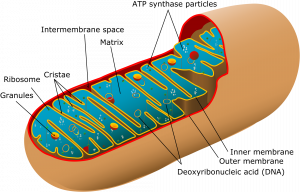Complete Guide to Mitochondria – Structure, Function
Mitochondria is a very powerful cell organelle that plays an active role in the production of energy. And not just that it is also important for the growth, and evolution of the cell as well as the organism. Because of this, it is one of the essential topics in biology subject, that the students must cover at all costs. Here in the below article, we are going to provide a comprehensive description of Mitochondria, their structure, various functions, and many more.
What is Mitochondria?
Mitochondria is a double membrane-bound organelle, that was first discovered by German Pathologist, Richard Altman, back in the year 1980. Moreover, this organelle is popularly referred to as the “Power House of the Cell” due to its ability to break down the nutrients in the food and convert them into energy which is used by the plants to perform various functions.
Besides this, as they are double membrane-bound organelles they are only found in Eukaryotic organisms. Furthermore, the Mitochondria are found in the cytoplasm of the cell, where it acts like a digestive system, taking part in various important digestion processes. And just that, many other important biochemical reactions like cellular respirations, also take place inside this component of the cell.
Structure of Mitochondria

Now that you have understood the basics of mitochondria DNA, let us talk about the various characteristics of the Mitochondria Structure, and also learn about its parts.
- The structure of mitochondria resembles a rod-shaped object.
- Mitochondria structure consists of three components, an inner membrane, an outer membrane, and a gel-like material called a matrix.
- The size or diameter range of the Mitochondria is limited to 0.5 to 1.0 micrometer.
- The outer membrane, which covers the mitochondrion consists of a large number of special proteins such as porins.
- Besides this, both the outer and inner membranes are composed of phosphide layers and proteins.
Functions of Mitochondria
As you can understand from the details given above, the Mitochondria perform various important functions, which we are going to explain briefly here in this section.
- It plays an active part in detoxifying ammonia in liver cells.
- It is very important for regulating the metabolic activity of the cell.
- Mitochondria also play a major role in various activities like cell growth, controlling of the cell cycle, cell signaling, and cell differentiation.
- Also helps in the regeneration and multiplication of cells.
- In order to build components of blood and various important hormones, estrogen, and testosterone.
- For the growth of the cell, it is essential for the said cell to have enough calcium concentrations, and Mitochondria help in maintaining these concentrations.
- The process of death of the cell or apoptosis is carried out successfully with the help of Mitochondria.
Conclusion
In the article above, we have provided a detailed guide on various topics, such as Mitochondria function, parts of mitochondria, and the structure of mitochondria. This subject includes many complex topics and chapters that are not very easy for the students to learn or understand on their own. Thus, to get a better understanding of the chapters in this subject, we suggest the students join the online coach classes. And Tutoroot is one such platform, which is currently offering Online Home Tutor programs for cost-effective and various amazing benefits. Visit the official platform to learn more about these benefits.
Frequently Asked Questions
Where are the mitochondria located?
Mitochondria are located in the Cytoplasm of the cell.
Do plant cells have mitochondria?
Yes, the Mitochondria component is present in both plants as well as animal cells.
Is mitochondria the powerhouse of the cell?
Yes, the Mitochondria are referred to as the powerhouse of the cell, as it produces energy in the cell.
